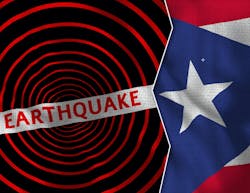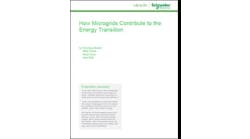Microgrids Up and Running Despite Earthquake and Massive Power Outage in Puerto Rico
With a large swath of Puerto Rico in the dark as a result of this week’s earthquake, there is some good news from the Rocky Mountain Institute (RMI). Microgrids in 10 schools are up and running.
The solar plus storage microgrids were recently installed by RMI, Save the Children and Kinesis Foundation. Built in remote regions, the microgrids offer sufficient battery and solar capacity to back up school libraries, administrative offices, kitchens, and critical water pumps indefinitely in the event of an outage.
“The grid is down but the systems are working,” said Roy Torbert, principal at RMI Islands Energy Program.
By motioncenter/Shutterstock.com
Puerto Rico schools were closed for the holiday when the earthquake struck, and they remain closed under government order until they can be inspected for structural safety. But RMI and Tesla, which supplied the microgrid batteries, were able to discern via remote monitoring systems that the microgrids are working. The monitoring systems, accessed by cell phone or computer, provide data on system performance.
The school microgrids were built in response to Hurricane Maria, which destroyed the island’s electric grid in September 2017, leaving some without power for more than a year.
Power outage could be lengthy
Once again many on the island face uncertainty about how long they will be in the dark, given damage to power generators in the southern portion of the island. News reports say that Costa Sur Power Plant, which supplies about 25% of the island’s power, could take up to a year to repair.
“The grid had not fully reovered from Maria so it was already in a fragile state prior to this earthquake,” said Patrick Meyers, director of business development for microgrids at Veolia, which is working on a range of projects in Puerto Rico, both public and private, from large baseload to manufacturing facilities.
Agustín Carbó, former chairman of the Puerto Rico Energy Bureau and now senior manager at the Environmental Defense Fund (EDF), was in a tourist-heavy portion of San Juan when the 6.4-magnitude earthquake struck early Tuesday morning. He reported Thursday that the power remains out to the neighborhood, including a hospital, and he has no water service.
“Doctors are complaining on Facebook about not having power,” he said.
EDF has been pushing for more community microgrids and other resiliency efforts for the island, but progress has been slow with FEMA aid stalled and utility interconnection difficult, he said.
“This is a wakeup call that we cannot wait. The current grid is old-fashioned and needs to be modernized,” Carbó told Microgrid Knowledge.
The Puerto Rico Electric Power Authority (PREPA), the island’s utility, has proposed a new integrated resource plan (IRP) that segments the island into eight minigrids. But the plan is crawling through the regulatory process and microgrid advocates fear that the earthquake and power outage may lead to further delay. At issue is the plan’s use of natural gas, as well as opposition by PREPA to government rules that support microgrids. Hearings are scheduled for February, Carbó said.
The IRP delay is creating investment uncertainty, added Veolia’s Meyers. “Right now we don’t have an IRP, so nobody knows what the market is going to look like when one is finally approved. It’s hard to do the math when you don’t know what your costs are going to be,” he said.
Grassroots effort to build microgrids
Despite the obstructions to development, several microgrids have been built in Puerto Rico since Hurricane Maria, some by the military, others by communities, private entities and organizations.
Small, remote microgrids have avoided interconnection delays because they are completely independent from the grid.
“This earthquake is a tragedy. It does really test government institutions at a time when Puerto Rico is already suffering from the last disaster,” said RMI’s Torbert. “I think what you can learn from the microgrids and the way they’ve performed is that so much of community resilience is happening from the bottom up.”
RMI is now working with partners on a microgrid funding mechanism with the goal of creating 17 more microgrids on the island.
Other mainland organizations and companies are reporting that they are having difficulty checking on the status of microgrids, especially those in remote locations, because of damage to the island’s communications systems. Microgrid Knowledge will continue to report on them as we receive information. Read more about microgrids in Puerto Rico here.







